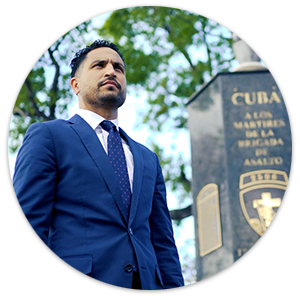When someone is injured in a slip and fall accident in Florida, they may want to hold the property owner responsible. This is often done through a slip and fall lawsuit. To win such a case, the injured person must meet the burden of proof. The burden of proof is the legal requirement that the injured party must show that the property owner was responsible for the conditions that led to the accident. This process can be challenging, and it requires a clear understanding of how the law applies in Florida. At, The Guzman Firm, PLLC, we are here to guide you through the legal process and help you navigate the complexities of your case.
Richard Guzman’s expertise focuses on one primary objective: to offer tactical legal analysis, guidance, and result-driven solutions. The Guzman Firm is dedicated to providing you with the knowledgeable and competent counsel you deserve.
Attorney Richard Guzman
Slip and fall cases can occur in a variety of places, including stores, parking lots, restaurants, and even private homes. The key issue is whether the property owner was negligent, meaning they did not take proper care to keep the area safe. In Florida, property owners have a duty to make sure their premises are safe for people who are lawfully on their property. If they fail to do this, and someone is injured as a result, they may be held liable. However, meeting the burden of proof is not as simple as just showing that an injury happened. The injured person must prove certain elements to succeed in their case.
Understanding the Duty of Care
In Florida, property owners owe a duty of care to people who are on their property legally. This means that they are responsible for taking reasonable steps to keep the premises safe. For example, if there is a spill on the floor of a grocery store, the store owner or staff must clean it up within a reasonable time. If they do not, and someone slips and falls, they may be liable for the injuries. However, it is important to note that the injured person must prove that the property owner knew or should have known about the dangerous condition and failed to fix it.
The duty of care depends on the relationship between the property owner and the person who is injured. If the injured person is an invitee, such as a customer in a store, the property owner has a higher duty of care. This means that the owner must regularly inspect the premises and fix any dangerous conditions that could cause harm. If the injured person is a licensee, like a social guest, the property owner still owes a duty to keep the premises safe but is not required to inspect as frequently. For trespassers, the duty of care is much lower. A property owner is generally not responsible for injuries to trespassers unless they intentionally create a dangerous situation.
“Richard is deeply invested in his community and is a professional of purpose and integrity. As our legal counsel, his strategic approach, proactive communication, and commitment to our organization’s needs and goals have helped us navigate challenges as well as build important partnerships.” “I go to Richard Guzman because of trust. He was recommended by my dear sister that had the pleasure of working with Mr. Guzman. By having a direct recommendation, I did not doubt that he could ease my worries and that I would be backed by a knowledgeable, trustworthy professional.”![]()
Dejha C.
![]()
Piero S.
Proving Negligence in Slip and Fall Cases
To meet the burden of proof in a slip and fall lawsuit, the injured person must prove that the property owner was negligent. Negligence occurs when someone fails to act with the level of care that a reasonable person would have used in the same situation. In slip and fall cases, the injured person must show that the property owner either created the dangerous condition or knew about it and did nothing to fix it.
Proving negligence involves several key elements. First, the injured person must show that the property owner had a duty of care. This means proving that the property owner was responsible for maintaining the safety of the premises. Second, the injured person must show that the property owner breached this duty by failing to fix or warn about a dangerous condition. Third, the injured person must prove that the breach of duty caused their injuries. Finally, the injured person must show that they suffered actual damages, such as medical bills or lost wages, as a result of the fall.
In Florida, slip and fall cases can be complicated because of the state’s comparative negligence law. This law means that if the injured person was partly at fault for the accident, their compensation may be reduced. For example, if someone was not paying attention while walking and slipped on a wet floor, they may be found partially responsible for their injuries. If the court finds that the injured person was 20 percent at fault, their damages will be reduced by 20 percent.
The Role of Evidence in Meeting the Burden of Proof
In any slip and fall case, evidence is crucial to meeting the burden of proof. The injured person must gather evidence to show that the property owner was negligent. This can include photographs of the dangerous condition, witness statements, surveillance footage, and maintenance records. Medical records showing the extent of the injuries are also important.
One of the most important pieces of evidence in a slip and fall case is proof that the property owner knew or should have known about the dangerous condition. This can be difficult to prove, especially if the hazard was temporary, such as a spill that was cleaned up shortly after the fall. However, if the dangerous condition existed for a long time, the injured person may be able to prove that the property owner had enough time to notice and fix it. For example, if a leak in the ceiling caused a puddle to form on the floor, and the leak had been there for several days, the property owner likely should have known about it and taken steps to fix it.
In some cases, the injured person may need to rely on testimony from someone who knows about the property’s maintenance practices. This could include a former employee or someone who has witnessed the property owner’s failure to address dangerous conditions in the past. This type of testimony can help show that the property owner was aware of the hazard and failed to take action.
Overcoming Challenges in Proving Slip and Fall Cases
Proving a slip and fall case in Florida is not always easy. Property owners often defend themselves by arguing that they were not aware of the dangerous condition or that they took reasonable steps to fix it. They may also argue that the injured person was responsible for their own injuries. For example, the property owner might claim that the injured person was not paying attention, was wearing inappropriate footwear, or ignored warning signs.
Another common defense is that the dangerous condition was open and obvious. This means that the property owner claims that the hazard was so clear that a reasonable person would have seen it and avoided it. For example, if a store placed a large sign near a spill warning customers to be careful, the property owner might argue that the injured person should have seen the sign and taken precautions.
To overcome these challenges, the injured person must present strong evidence and show that the property owner was indeed negligent. This is why gathering evidence immediately after the accident is so important. Even if the property owner claims they were not aware of the hazard, showing that the dangerous condition had existed for a long period of time can help prove negligence. Additionally, showing that the property owner failed to follow proper maintenance procedures can strengthen the injured person’s case.
How Florida’s Slip and Fall Laws Affect Your Case
Florida’s slip and fall laws play a crucial role in how these cases are handled. In 2010, Florida passed a law that made it more difficult for injured people to win slip and fall cases in certain situations. Under this law, if the fall occurred because of a transitory substance, such as a spill or other temporary condition, the injured person must prove that the property owner knew or should have known about the condition and had time to fix it.
This law means that in many slip and fall cases, the injured person must prove that the property owner had “actual” or “constructive” knowledge of the hazard. Actual knowledge means that the property owner was directly aware of the dangerous condition, while constructive knowledge means that the condition existed for such a long period that the property owner should have known about it. Proving constructive knowledge can be done by showing that the dangerous condition was present for a long time, or that the hazard occurred regularly and was therefore predictable.
This change in the law makes it even more important to gather strong evidence in slip and fall cases. Injured people must show not only that a dangerous condition existed, but that the property owner was aware of it or should have been aware of it.
If you or a loved one has been injured in a slip and fall accident in Florida, it is important to seek legal help to ensure that your rights are protected. Proving negligence in a slip and fall case can be complicated, but having the right legal support can make all the difference. The Guzman Firm, PLLC is here to help you navigate the legal process and fight for the compensation you deserve. Contact us today to schedule a consultation and learn more about how we can assist you with your slip and fall lawsuit.
